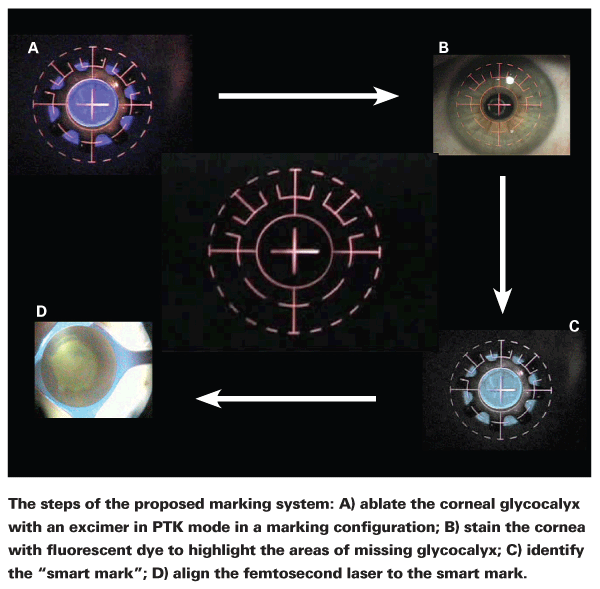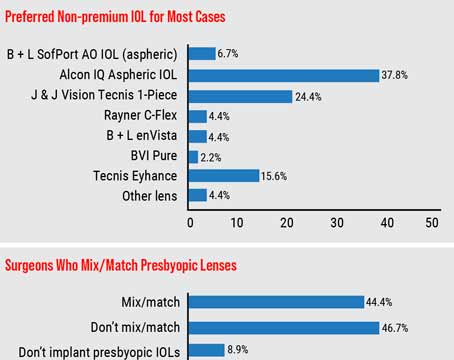Though the IntraLase femtosecond laser makes very good flaps consistently, methods for centering it definitely have room for improvement. There's got to be a more precise way to center this advanced device than daubing a blob of ink on the cornea with a pen. To that end, I've worked out a method of centration marking using existing excimer laser tracking technology that would be more accurate than the pen and would have potential uses in other corneal procedures, too. Though it will take some cooperation from industry to develop the exact laser marking system I propose, the rudiments are in place already. Here's an explanation of the marking system and its possible advantages over the methods we're currently using.
The State of
The problem with current methods of centering the IntraLase is, if you simply use the suction ring to position the laser and then applanate the cornea, you distort the entire anterior segment. So, the spot that you perceive as the entrance pupil and the location of the actual entrance pupil are, most likely, in two different places. This is compounded by the fact that it's difficult to be perfect in centering the IntraLase 100 percent of the time, so there's always a chance you're going to be off-center to some degree, usually 0.5 to
1 mm. Also, the iris can get ischemic and dilate irregularly upon applanation, hindering your centration ability further. Though there's a mechanism for moving the laser head around to some degree, chances are the procedure won't be perfectly centered.
To overcome these issues, surgeons have suggested using a pen to mark the center of the visual axis. This is crude at best, since the mark is actually quite large and encompasses more surface area than just one precise center mark. In addition, these pen marks don't compensate for pupil centroid shifts or cyclorotation, and, in some cases, may simply be gone by the time you need them. Other surgeons have suggested using iris registration technology comparable to that used in the the AMO/Visx excimer laser system, in which you identify marks on the iris to align the procedure. The problem with this is that iris ischemia, pupil distortion from applanation and distortion of the entire anterior segment can cause the iris landmarks to be imprecise or misleading.
Fortunately, in most cases, a little decentration of the IntraLase doesn't have a negative effect, and the procedure yields good outcomes. However, for some patients, such as hyperopes or mixed astigmats, it's possible that a decentration will have a negative effect, since centration is important in such cases. You would also have difficulty achieving proper centration with our current methods if you had to perform a treatment in which it was crucial to be on the axis of the eye, such as creating a pocket for a presbyopic corneal inlay or making an oval flap.
A New Way to Make Your Mark
I call my proposed marking system a "smart mark," and it would use existing technologies, such as the AMO iris registration camera technology and the excimer laser's phototherapeutic keratectomy mode, to accurately identify and mark the precise location of the entrance pupil and note the pupil centroid shift and the axis of astigmatism. It would also provide information on both cyclorotation and the anticipated location of the proposed stromal surgery. Determining the best marking pattern to accomplish all this will require some further research. However, at its simplest, we could use the laser's PTK mode to mark a cornea simply by removing a couple of microns of the corneal glycocalyx in the central cornea, and maybe in the periphery as well for orientation purposes. We could then use a dye to stain the areas where the glycocalyx is missing, to differentiate it from areas where it's still present, resulting in the smart mark.
This mark could be any shape, size or diameter that you need, such as a bull's-eye or series of crosses, limited only by the excimer's considerable ability to generate ablation shapes. This is where an excimer company's assistance would be valuable: programming the shapes most useful for creating the centration target mark(s). I'm currently in talks with one company about making smart marks available, and I'm hopeful some progress will be made on that front.
In addition to centering the IntraLase for LASIK procedures, the marks could also be useful for marking the following:
• the exact location for astigmatic keratotomy incisions;
• the location for corneal trephinations in femtosecond-enabled corneal transplants;
• the corneal center for creation of a stromal pocket for a presbyopic corneal inlay;
• the exact areas where you'd want to insert corneal ring segments; and
• an accurate excision zone of an intrastromal lenticule for refractive purposes (such as in Carl Zeiss Meditec Visumax's novel intrastromal FLEX procedure), reducing error from decentration and cyclorotation that could negatively impact the procedure's result.

The marking may be very useful for helping IntraLase-enabled keratoplasty to deliver superior control of astigmatism. It's possible that smart marks on the host and donor tissue will enhance the ability to align the apex of the donor button over the visual axis of the host. You could also integrate optical coherence tomography with the smart marks to enhance your ability to rotate the donor tissue button to further reduce the amount of induced astigmatism and more accurately match the thicknesses of the graft and the host.
Though smart marks don't exist in a finished form yet, I've used the excimer to mark cadaver corneas using rose bengal and then cut well-centered flaps in them, proving that the concept can work. However, rose bengal is a relatively dense dye and, as such, could block incoming femtosecond pulses. For this reason, a dye in the fluorescent light spectrum would be more desirable, as it wouldn't block any pulses at all.
So, the building blocks for creating smart marks are in place, and the technology is already present in most of our refractive-surgery practices. If the excimer-laser makers take the next step and design an algorithm that can create the marking patterns, even simple ones, we can take all of our IntraLase-related procedures to the next level of accuracy.
Dr. Will is in private practice and lectures frequently on refractive surgery.




